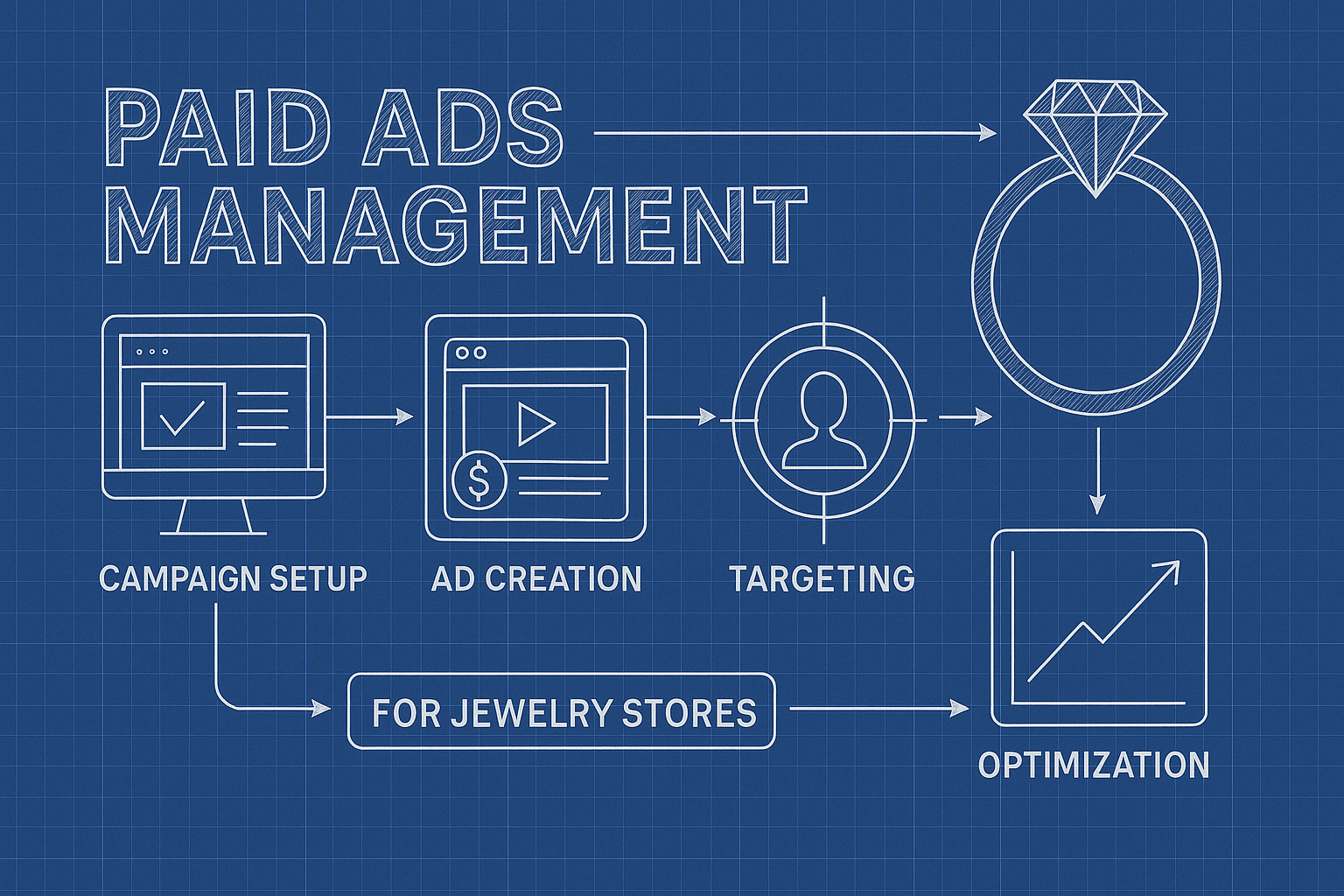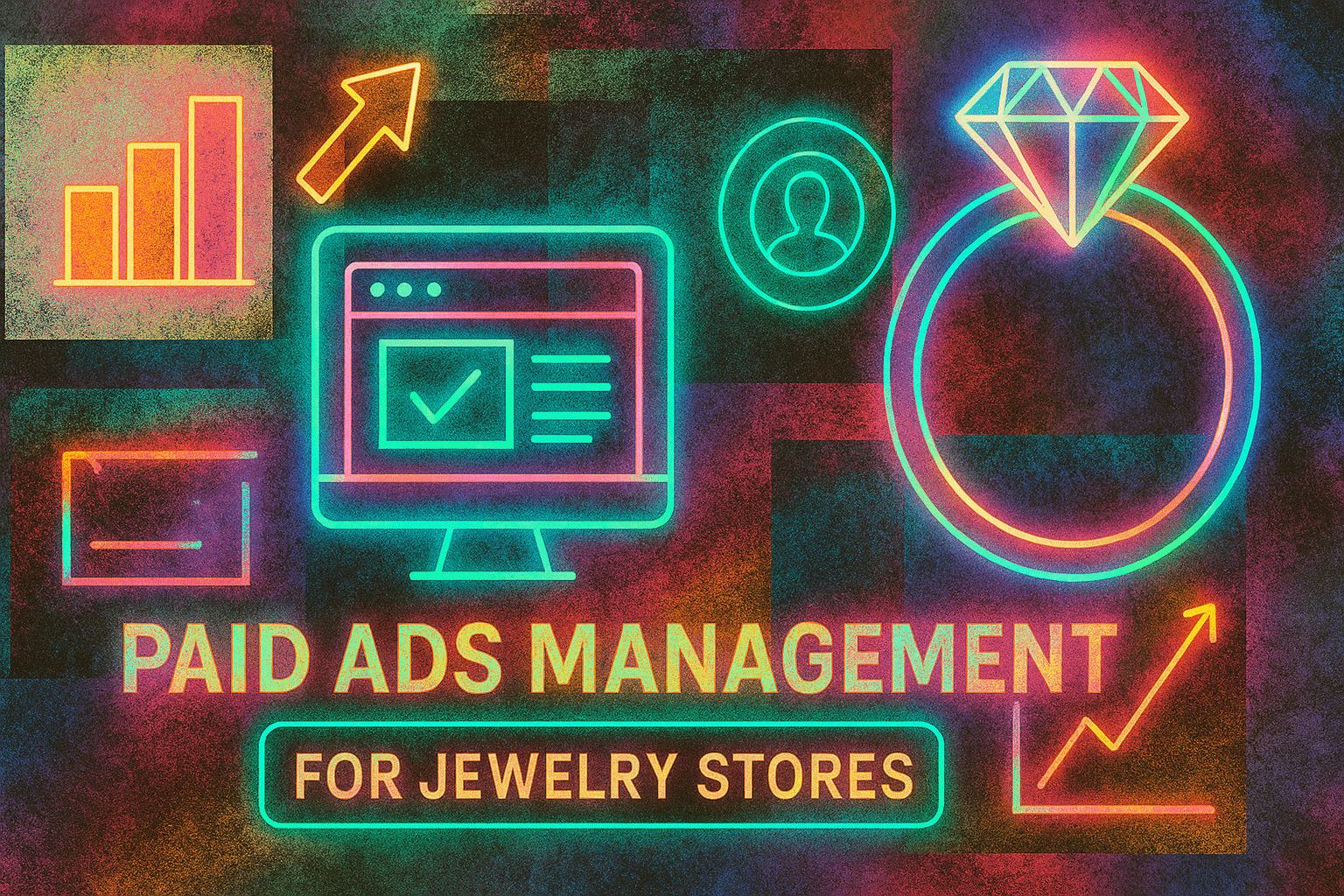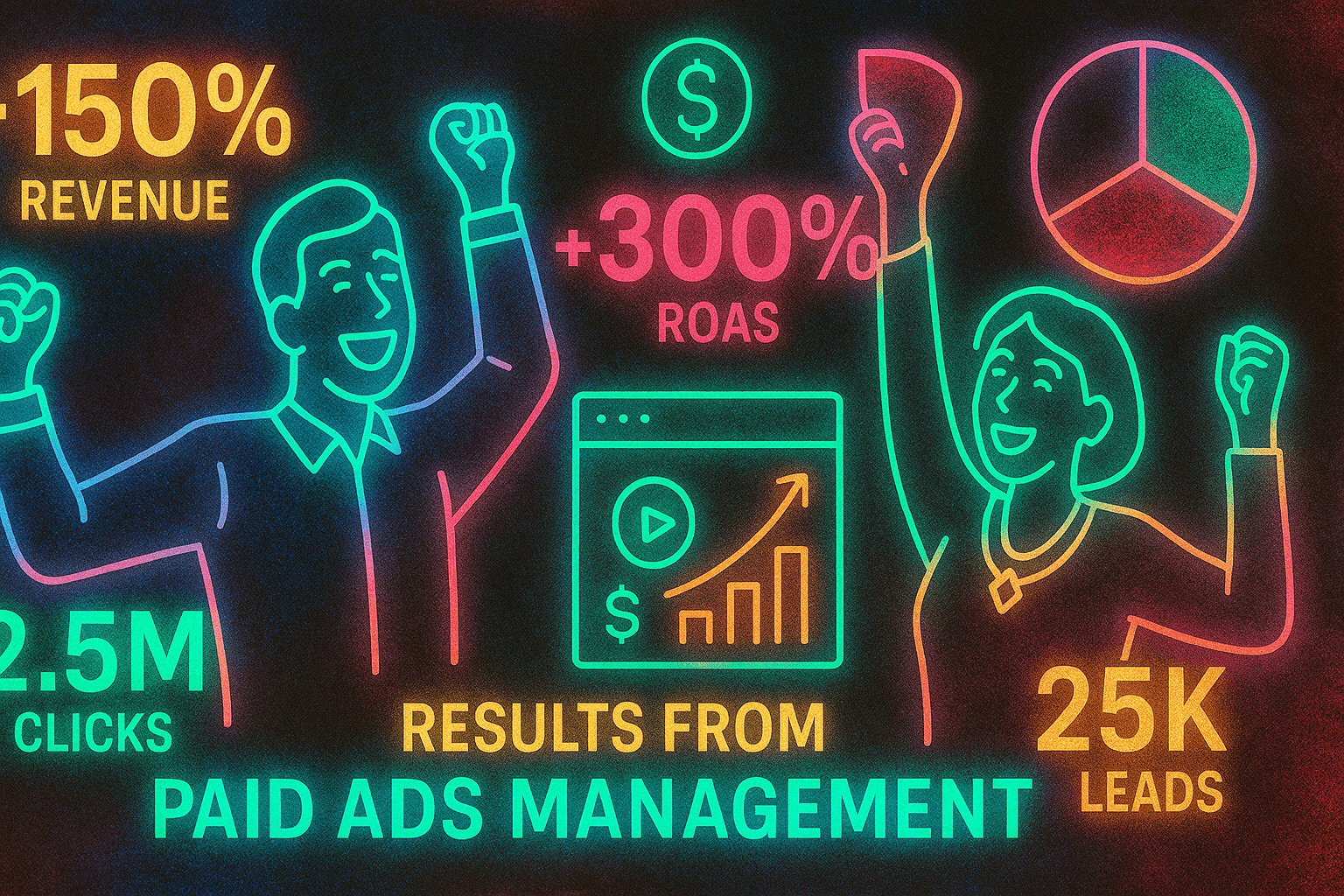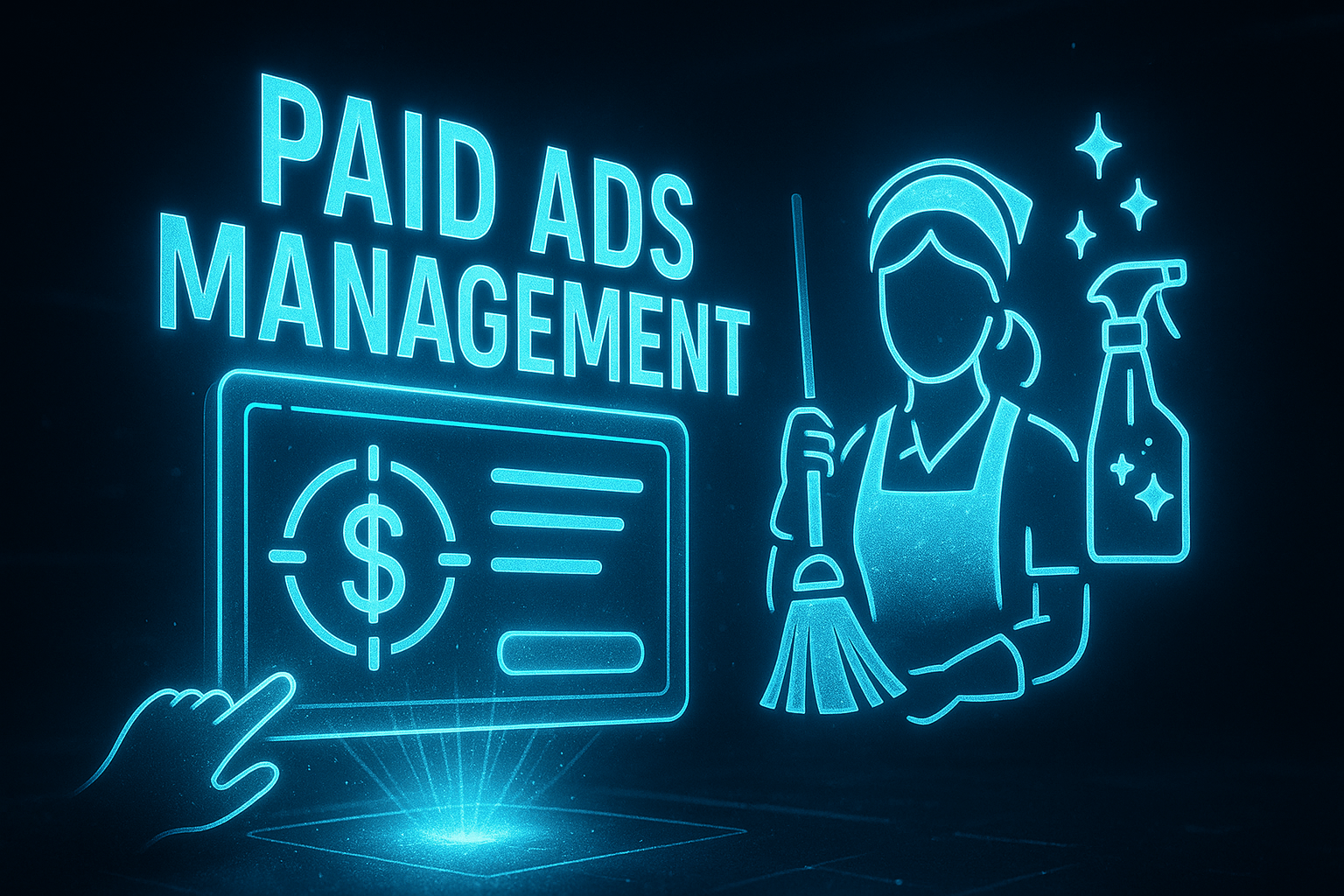Complete Paid Ads Management Guide for Jewelry Stores: Strategy, Execution & ROI
by Design Delulu Editorial · October 15, 2025

Smart, fast, and measurable. Here's how paid ads management helps Jewelry Stores win.
The jewelry industry faces a unique advertising challenge: you're selling emotion, trust, and lifetime value wrapped in precious metals and stones. Unlike commodity products, jewelry purchases involve high consideration periods, significant price points, and deeply personal decision-making. When a potential customer searches for 'engagement rings near me' or sees your diamond collection on Instagram, they're not just browsing—they're beginning a journey that could lead to one of the most important purchases of their lives.
This is precisely why generic paid advertising approaches fail jewelry retailers. Your advertising strategy needs to account for extended customer journeys, seasonal spikes (Valentine's Day, holiday season, wedding season), diverse price points from fashion jewelry to investment pieces, and the critical importance of visual storytelling. Professional paid ads management for jewelry stores bridges the gap between your beautiful products and the customers actively searching for them, while building brand recognition among those who will need your services in the future.

Why Jewelry Stores Need Specialized Paid Ads Management
Jewelry retail operates in a distinct marketing ecosystem that demands specialized expertise. The average engagement ring purchase involves 3-6 months of research, multiple touchpoints across devices and platforms, and significant influence from partners, friends, and family members who may never appear in your analytics.
Generic advertising agencies treat jewelry like any other e-commerce product, but that approach ignores fundamental market realities:
- High average order values require sophisticated attribution models that track the full customer journey, not just last-click conversions
- Emotional purchase decisions demand creative that tells stories and builds trust, not just product specifications
- Seasonal concentration means your ad spend needs intelligent pacing—67% of engagement ring purchases happen between November and February
- Local and online hybrid behavior requires coordinated campaigns that drive both foot traffic and e-commerce sales
- Trust and credibility concerns necessitate strategic use of reviews, certifications, and guarantees in ad creative
Professional paid ads management addresses these complexities through industry-specific strategies that recognize jewelry isn't just another product category—it's a specialized vertical requiring dedicated expertise, platform knowledge, and creative approaches tailored to luxury consumer behavior.
Core Components of Effective Jewelry Store Paid Advertising
Successful paid advertising for jewelry retailers requires orchestration across multiple platforms, each serving distinct purposes in the customer acquisition funnel. Here's how best-in-class jewelry stores structure their paid media approach:
Google Search Campaigns: Capturing High-Intent Traffic
Search campaigns form the foundation of jewelry store advertising because they capture customers actively looking for your products. However, keyword strategy requires nuance:
- Branded campaigns protect your brand name from competitors bidding on your trademark terms
- Category campaigns target generic terms like 'diamond engagement rings' or 'custom jewelry design'
- Competitor campaigns strategically bid on rival brand names where legally and ethically appropriate
- Local intent campaigns focus on 'jewelry stores near me' and location-specific queries
- Long-tail campaigns capture specific searches like 'rose gold halo engagement ring under $5000'
The key is granular campaign structure that allows independent budget allocation and bid strategies for each intent level. High-intent conversion terms deserve aggressive bidding, while research-phase keywords require lower cost-per-click strategies with patient nurturing.
Google Shopping & Product Feed Optimization
Shopping campaigns showcase your jewelry inventory directly in search results with images, prices, and key details. Success requires meticulous product feed optimization:
- High-quality product photography with consistent white or lifestyle backgrounds
- Detailed titles including metal type, stone details, style, and brand (e.g., '14K White Gold Round Diamond Halo Engagement Ring 1.5ct')
- Complete attribute mapping for Google's product taxonomy including gender, material, and stone type
- Custom labels for margin, seasonality, and bestseller segmentation
- Competitive pricing signals that position your products appropriately in the market
Advanced jewelry advertisers use product segmentation strategies that allocate higher budgets to high-margin pieces while maintaining visibility across the full catalog.
Meta Platforms: Building Desire and Retargeting
Facebook and Instagram excel at upper-funnel awareness and strategic retargeting. Jewelry is inherently visual, making these platforms ideal for showcasing craftsmanship and lifestyle positioning:
- Dynamic product ads retarget visitors with specific items they viewed on your website
- Collection ads showcase multiple pieces in scrollable, immersive formats
- Video storytelling demonstrates the sparkle, detail, and scale that static images miss
- Lookalike audiences find new customers similar to your best buyers
- Engagement campaigns build brand awareness before asking for the purchase
The most effective approach uses sequential retargeting—someone who viewed engagement rings but didn't purchase sees testimonials and education content, then ring recommendations, then a limited-time offer, creating multiple touchpoints without ad fatigue.
Account Architecture & Budget Strategy
Professional campaign structure separates efforts by intent, audience temperature, and business objective:
| Campaign Type | Purpose | Typical Budget Allocation |
|---|---|---|
| Brand Protection | Defend against competitor bidding | 5-10% |
| High-Intent Search | Capture ready buyers | 30-40% |
| Shopping Campaigns | Product discovery & conversions | 20-30% |
| Retargeting | Convert warm traffic | 15-20% |
| Prospecting | Audience building | 10-15% |
This allocation shifts based on seasonality—holiday periods may see 50% or more allocated to high-intent and shopping campaigns, while slower periods emphasize audience building and brand awareness.
Creative Strategy: Making Jewelry Shine in Digital Ads
In jewelry advertising, creative quality directly impacts conversion rates more than almost any other industry. A poorly photographed $5,000 ring will underperform a beautifully presented $3,000 alternative every time.
Photography and Video Requirements
Professional jewelry photography requires specialized techniques that generic product photographers often lack:
- Macro detail shots that show stone clarity, setting details, and metalwork craftsmanship
- Hand modeling that demonstrates scale and wearability without distracting from the jewelry
- Lifestyle context showing jewelry in real-world scenarios that trigger emotional connections
- 360-degree views for high-value pieces that customers want to examine from every angle
- Video with proper lighting to capture sparkle, fire, and movement that static images cannot convey
Investment in professional jewelry photography typically returns 3-5x through improved ad performance and conversion rates. Smartphones and amateur photography simply cannot capture the qualities that make jewelry purchases compelling.
Ad Copy That Converts Jewelry Shoppers
Effective jewelry ad copy balances emotion with practical details:
- Lead with outcomes, not features—'Make Her Say Yes' outperforms 'Round Cut Diamond Ring'
- Address objections proactively—'Free Resizing, Lifetime Warranty, 60-Day Returns'
- Create urgency authentically—'Only 3 Left in Stock' or 'Custom Orders Close December 15th'
- Use social proof—'2,400+ Five-Star Reviews' or 'Featured in Brides Magazine'
- Specify value propositions—'Certified Diamonds at 40% Below Retail' or 'In-House Master Jeweler'
A/B testing reveals that jewelry shoppers respond strongly to trust signals and specificity. Vague claims about quality underperform concrete details like certification sources, appraisal inclusion, or specific guarantees.
Testing Matrix for Continuous Improvement
Systematic creative testing identifies winning combinations:
- Image variations: white background vs. lifestyle, close-up vs. full view, hand-modeled vs. standalone
- Headline approaches: emotional vs. practical, question-based vs. statement, price-forward vs. value-forward
- Call-to-action tests: 'Shop Now' vs. 'Browse Collection' vs. 'Design Your Ring'
- Offer structures: percentage discount vs. dollar discount vs. free shipping vs. gift with purchase
- Audience messaging: gift-buyer messaging vs. self-purchase messaging vs. milestone celebration
Maintaining a structured testing calendar ensures you're constantly improving performance rather than running the same creative until it fatigues and performance degrades.

Audience Targeting & Segmentation for Jewelry Advertisers
Jewelry purchase behavior varies dramatically across demographic segments, life stages, and occasions. Sophisticated audience targeting recognizes these differences and crafts appropriate messaging for each group.
Demographic Segmentation Strategies
Different customer segments require distinct approaches:
- Engagement ring shoppers (typically male, ages 25-35): Emphasize educational content, certification, payment plans, and romantic presentation
- Fashion jewelry buyers (primarily female, ages 25-55): Focus on trends, versatility, layering options, and self-expression
- Gift purchasers (all demographics): Highlight gift packaging, delivery timing, gift messaging, and return policies
- Fine jewelry investors (ages 40+, higher income): Stress authenticity, appraisal, resale value, and heritage craftsmanship
- Wedding party shoppers: Promote group discounts, coordination services, and timeline guidance
Each segment sees customized landing pages and ad creative that speaks to their specific needs, price sensitivity, and decision criteria.
Behavioral & Interest Targeting
Beyond demographics, behavioral signals indicate purchase readiness:
- Wedding and engagement interest: Recently engaged, wedding planning, bridal magazine readers
- Life milestone indicators: Anniversaries, graduations, holidays, birthdays
- Fashion and luxury interest: Designer fashion followers, luxury brand enthusiasts, fashion magazine readers
- Gift-giving behavior: People who regularly purchase gifts online, previous holiday shoppers
- Jewelry research signals: YouTube watch history for jewelry content, Pinterest board creation, jewelry blog readers
Layering behavioral and demographic targeting creates high-probability audience segments that convert at significantly higher rates than broad targeting while maintaining reasonable reach.
Negative Audience Strategy
Equally important is excluding inappropriate audiences to improve efficiency:
- Recent purchasers (exclude for 90-180 days to avoid waste)
- Low-value browsers who repeatedly visit but never add to cart
- Geographic exclusions for areas you don't serve or ship to
- Competitor employees and known non-customer traffic sources
- Price-incompatible audiences for luxury campaigns (exclude bargain-hunter signals)
Strategic exclusions can improve campaign efficiency by 15-25% by preventing wasted impressions on unlikely converters.
Measurement, Analytics & Performance Optimization
Jewelry stores face unique attribution challenges due to high consideration periods and multi-device shopping behavior. A customer might discover your brand on Instagram Monday, research on desktop Wednesday, visit the store Saturday, and purchase online the following Tuesday. Standard last-click attribution would credit only that final interaction, completely missing the journey that made the sale possible.
Key Performance Indicators for Jewelry Advertising
Track metrics across the full funnel, not just conversions:
- Upper funnel: Reach, impressions, cost per thousand impressions (CPM), video view rate
- Mid funnel: Click-through rate (CTR), cost per click (CPC), landing page views, time on site
- Lower funnel: Add-to-cart rate, initiated checkout rate, cost per acquisition (CPA), return on ad spend (ROAS)
- Business outcomes: New customer acquisition cost, customer lifetime value, payback period, year-over-year growth
For jewelry stores with both e-commerce and physical locations, store visit tracking and call tracking must integrate with online conversion data to capture the complete picture.
Attribution Modeling for Complex Journeys
Multi-touch attribution reveals which channels truly drive sales:
- First-touch attribution credits the initial discovery channel (useful for brand awareness evaluation)
- Last-touch attribution credits the final interaction (standard but incomplete for jewelry)
- Linear attribution distributes credit equally across all touchpoints
- Time decay attribution gives more credit to recent interactions
- Position-based attribution emphasizes first and last touch with some credit to mid-journey interactions
Most jewelry advertisers find position-based or time decay models most accurately represent their customer journeys, appropriately crediting both awareness and conversion activities.
Optimization Cadence & Testing Discipline
Systematic optimization follows a structured calendar:
- Daily: Monitor spend pacing, check for technical issues, respond to performance anomalies
- Weekly: Review performance by campaign, adjust bids, pause underperformers, scale winners
- Bi-weekly: Launch new creative tests, adjust audience targeting, refine negative keywords
- Monthly: Comprehensive performance analysis, strategic budget reallocation, competitive analysis
- Quarterly: Full strategic review, annual planning updates, creative direction refresh
This cadence ensures responsive tactical optimization without overreacting to short-term fluctuations or making changes before collecting sufficient statistical significance.
Seasonal Planning & Budget Pacing for Jewelry Retailers
Jewelry sales follow predictable seasonal patterns that demand strategic budget allocation. Unlike industries with steady year-round demand, jewelry retailers might see 40% of annual revenue concentrated in November and December alone.
Annual Calendar Planning
Structure your advertising investment around these key periods:
- Valentine's Day (January-February): Second-largest jewelry sales period, engagement ring spike, romantic gift focus
- Wedding Season (April-June): Bridal party jewelry, wedding bands, gift opportunities
- Mother's Day (April-May): Short but intense gift-buying period, typically fashion jewelry focused
- Graduation Season (May-June): Gift jewelry, first fine jewelry purchases for graduates
- Holiday Season (November-December): Largest sales period, engagement rings, luxury gifts, fashion jewelry
Smart budget pacing means increasing spend 4-6 weeks before major shopping periods to build awareness, then maintaining aggressive conversion-focused campaigns during the peak selling window.
Competitive Pressure & Bid Adjustment
During peak periods, increased competition drives up advertising costs. Plan for these realities:
- CPCs increase 40-70% during holiday season as all jewelry retailers compete for the same customers
- Conversion rates often improve despite higher costs because traffic quality increases with higher purchase intent
- Early-bird strategies capture customers before competition intensifies (e.g., 'Shop Early for Guaranteed Delivery')
- Budget reserves allow you to remain competitive during unexpected demand spikes
Jewelry stores that plan seasonal budget increases six months in advance outperform those that react to market conditions without preparation.

Common Paid Advertising Mistakes Jewelry Stores Make
Even sophisticated jewelry retailers fall into predictable traps that undermine advertising performance. Recognizing and avoiding these mistakes protects your investment:
- Generic landing pages: Sending all ad traffic to your homepage instead of relevant collection pages tanks conversion rates
- Ignoring mobile experience: Over 60% of jewelry research happens on mobile, yet many sites have poor mobile optimization
- Weak calls-to-action: Timid CTAs like 'Learn More' underperform direct asks like 'Shop Engagement Rings' or 'Schedule Consultation'
- No retargeting strategy: Failing to re-engage the 97% of visitors who don't convert on first visit wastes top-of-funnel investment
- Poor product data quality: Incomplete or inaccurate product information reduces Shopping campaign performance
- Set-and-forget campaigns: Letting campaigns run without optimization allows performance to degrade over time
- Insufficient creative variety: Running the same ad creative for months causes creative fatigue and declining performance
- Neglecting review strategy: Not leveraging seller ratings extensions and customer testimonials in ads
Each of these mistakes represents 10-30% performance loss individually. Combined, they can make paid advertising appear unprofitable when the issue is execution, not channel viability.
Building Your Jewelry Store Paid Ads Management System
Transitioning from reactive advertising to systematic paid media management requires establishing repeatable processes, clear documentation, and defined accountability.
Essential Tools & Technology Stack
Professional jewelry store advertising requires these core platforms:
- Google Ads for search, shopping, display, and YouTube campaigns
- Meta Business Manager for Facebook and Instagram advertising
- Google Analytics 4 for comprehensive website behavior and conversion tracking
- Call tracking software to attribute phone inquiries to specific campaigns
- Tag management platform (Google Tag Manager) for simplified tracking implementation
- Data studio or similar for unified reporting across platforms
- CRM integration to connect ad sources to actual sales and customer lifetime value
These tools work together to provide end-to-end visibility from ad impression through purchase and beyond, enabling intelligent optimization decisions based on complete data.
Team Structure & Responsibilities
Whether you manage advertising in-house or partner with an agency, clear role definition ensures nothing falls through the cracks:
- Strategy & planning: Develops overall approach, budget allocation, seasonal planning, competitive positioning
- Campaign management: Builds campaigns, manages bids, conducts optimization, implements tests
- Creative development: Produces ad copy, designs creative assets, coordinates photography and video
- Analytics & reporting: Tracks performance, identifies trends, creates dashboards, calculates ROI
- Landing page optimization: Ensures post-click experience matches ad promises and drives conversions
Small jewelry retailers might consolidate these roles into one or two people, while larger operations build specialized teams for each function.
Getting Started: 90-Day Launch Plan
Implementing professional paid ads management follows a structured rollout:
Weeks 1-2: Foundation & Audit
- Audit existing campaigns for quick wins and critical issues
- Implement proper conversion tracking and analytics
- Document business goals, constraints, and success metrics
- Conduct competitive analysis and keyword research
Weeks 3-4: Strategy & Architecture
- Design full-funnel campaign structure
- Develop audience segmentation strategy
- Create creative testing matrix and production timeline
- Establish measurement framework and reporting cadence
Weeks 5-8: Build & Launch
- Construct campaigns with proper settings and targeting
- Produce initial creative assets and ad variations
- Implement tracking and quality assurance testing
- Launch campaigns with careful budget pacing
Weeks 9-12: Optimize & Scale
- Collect performance data and identify trends
- Optimize based on learnings and double down on winners
- Launch additional tests and expand successful campaigns
- Refine attribution models and reporting
This methodical approach ensures strong foundations rather than rushed implementation that requires expensive corrections later.
Partnering With a Specialized Jewelry Advertising Agency
Many jewelry retailers reach a point where internal management hits capacity or expertise limits. Professional agencies bring specialized knowledge, dedicated resources, and proven systems that accelerate results.
What to Look for in a Jewelry Marketing Partner
Not all digital marketing agencies understand jewelry retail. Evaluate potential partners on:
- Jewelry-specific experience: Have they managed campaigns for jewelry stores, not just generic e-commerce?
- Platform expertise: Do they demonstrate advanced knowledge of Google Ads, Meta platforms, and emerging channels?
- Attribution sophistication: Can they track and optimize for your specific customer journey and sales cycle?
- Creative capabilities: Will they produce compelling jewelry-focused creative, or just manage bids?
- Reporting transparency: Do they provide clear, actionable reporting that connects ad spend to business outcomes?
- Strategic partnership approach: Are they advisors and collaborators, or order-takers?
The right partner feels like an extension of your team, understanding your business goals and bringing proactive recommendations that drive measurable growth.
Investment Expectations & ROI Timeframes
Professional paid ads management for jewelry stores typically requires:
- Management fees: 15-25% of ad spend, or fixed monthly retainers starting at $2,500-$5,000
- Minimum ad budgets: $5,000-$10,000 monthly for meaningful results across multiple platforms
- Initial setup investment: $3,000-$10,000 for strategy, tracking implementation, and campaign architecture
- Creative production: Variable based on photography, video, and design needs
Realistic ROI expectations: See initial improvements within 30-60 days as quick optimizations take effect. Achieve full potential at 90-120 days once sufficient data enables sophisticated optimization. Most jewelry stores target 300-500% ROAS on direct attribution, with additional unmeasured value from assisted conversions.
Frequently Asked Questions
Let’s level up your Jewelry Stores business
Need services that actually move the needle for Jewelry Stores? See our approach, pricing, and timelines—then book a quick call.
Additional Resources
- Schedule Your Jewelry Marketing Strategy Call
Get a custom paid advertising strategy for your jewelry store. In this 30-minute consultation, we'll review your current performance, identify immediate opportunities, and outline a roadmap for sustainable growth through professional paid ads management.
- View Our Jewelry Marketing Portfolio
See real results from jewelry stores we've helped grow through strategic paid advertising campaigns. Browse case studies showcasing ROAS improvements, conversion rate optimization, and creative strategies that drove measurable revenue growth.
- Free Jewelry Marketing Tools & Resources
Access our collection of free tools designed specifically for jewelry retailers: ROAS calculators, seasonal budget planning templates, creative testing frameworks, and paid advertising checklists to improve your campaigns immediately.
Related Reading

Specialized paid ads management for immigration law firms. Get more qualified leads with data-driven PPC strategies, proven campaign structures, and expert optimization.

Discover how electricians use paid ads management to generate qualified leads, reduce cost-per-acquisition, and scale revenue. Strategy, KPIs, and proven framework inside.
